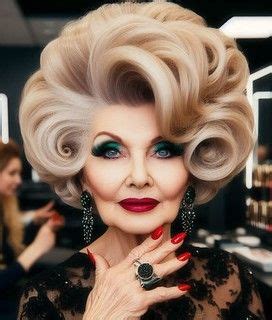Introduction
The silver bouffant wig has been making a resurgence in recent years, as an iconic symbol of glamour and elegance. These wigs, characterized by their voluminous, beehive-shaped silhouette and silver hue, have become a staple for celebrities, fashion enthusiasts, and anyone seeking a statement-making hairpiece. Here is everything you need to know about silver bouffant wigs, from their history to styling tips to common mistakes to avoid.

History of Silver Bouffant Wigs
The bouffant hairstyle originated in the 1950s, inspired by the desire for voluminous and dramatic hair. Wigs made with human or synthetic hair were used to achieve the signature shape, which was often adorned with hairspray, ribbons, and other embellishments.
In the 1960s, the bouffant wig became associated with glamour and femininity, particularly with the iconic style of Jackie Kennedy. The silver bouffant wig emerged as a variant in the 1970s, adding a futuristic and edgy touch to the classic silhouette.
Wearing a Silver Bouffant Wig
Styling Tips
- Use plenty of hairspray: A silver bouffant wig requires a strong hold to maintain its shape. Apply hairspray generously to the wig before teasing and styling.
- Tease the hair: Using a teasing comb or brush, gently backcomb the hair at the roots to create volume and lift. Be careful not to overdo it, as this can damage the wig.
- Shape the silhouette: Once the hair is teased, use your fingers or a brush to mold the desired shape. Create a rounded beehive at the crown and smooth the sides.
- Add accessories: Embellishments such as ribbons, hairpins, or headbands can enhance the look of a silver bouffant wig.
Common Mistakes to Avoid
- Over-teasing: Excessive teasing can damage the wig and make it look unnatural.
- Using too much hairspray: While hairspray is essential for hold, using too much can weigh down the wig and make it difficult to style.
- Ignoring the wig cap: The wig cap is crucial for keeping the wig in place and creating a smooth transition from hairline to wig. Make sure the cap fits securely and is the correct size for your head.
- Not brushing the wig: Regular brushing is important to prevent tangles and maintain the wig’s appearance.
Step-by-Step Approach to Styling a Silver Bouffant Wig
- Prepare your hair: Wash, condition, and blow dry your hair to remove any oils or tangles.
- Put on the wig cap: Place the wig cap over your hair and secure it around the nape of your neck.
- Place the wig: Adjust the wig on your head so that the hairline aligns with your natural hairline.
- Secure the wig: Use bobby pins or a wig grip to secure the wig in place.
- Tease the roots: Use a teasing comb or brush to gently backcomb the hair at the roots, starting from the crown.
- Shape the silhouette: Use your fingers or a brush to mold the hair into the desired beehive shape.
- Add hairspray: Apply hairspray generously to the wig to hold the shape.
- Finish with accessories: Add any desired embellishments, such as ribbons or headbands.
Applications of Silver Bouffant Wigs
Beyond the traditional use for special occasions, silver bouffant wigs have found novel applications in:
- Cosplay and entertainment: Wigs in this style are popular for dressing up as characters from period dramas, sci-fi movies, and anime.
- Drag performances: Silver bouffant wigs are often used by drag queens and performers to create exaggerated and glamorous looks.
- Fashion shoots and editorials: Fashion designers and photographers use these wigs to add drama and a touch of retro glam to their creations.
- Halloween costumes: Silver bouffant wigs can be incorporated into Halloween costumes to create a variety of characters, from witches to pop stars.
Table 1: Bouffant Wig Dimensions
| Wig Size | Crown Height | Silhouette Width |
|---|---|---|
| Small | 4-6 inches | 12-14 inches |
| Medium | 6-8 inches | 14-16 inches |
| Large | 8-10 inches | 16-18 inches |
Table 2: Bouffant Wig Materials
| Material | Advantages | Disadvantages |
|---|---|---|
| Human Hair | Natural appearance, breathable, durable | Expensive, requires more care |
| Synthetic Hair | Affordable, easy to style, less breathable | Can appear artificial, prone to tangling |
| Heat-Resistant Synthetic Hair | Can withstand heat styling (up to 350°F) | Melts if exposed to excessive heat |
Table 3: Effective Styling Strategies for Silver Bouffant Wigs
| Strategy | Purpose | Method |
|---|---|---|
| Backcombing at the roots | Create volume and lift | Gently brush hair against its natural direction |
| Using a teasing brush | Enhance teasing results | Comb with widely spaced bristles to distribute volume evenly |
| Applying hairspray in sections | Avoid clumping | Spray in short bursts and allow to dry before moving on |
| Using a rounded brush for shaping | Create a smooth and symmetrical silhouette | Brush hair up and outward to mold the shape |
Table 4: Silver Bouffant Wig Prices
| Wig Quality | Price Range |
|---|---|
| Basic | $50-$100 |
| Mid-range | $100-$200 |
| High-end | $200-$500 |
| Custom | $500+ |
Conclusion
The silver bouffant wig has emerged as a timeless and glamorous hairpiece, with a rich history and a wide range of applications. By following the styling tips, avoiding common mistakes, and choosing the right wig for your needs, you can achieve a stunning and unforgettable look with this iconic accessory. Whether you’re attending a special event, creating a costume, or simply embracing your glamorous side, a silver bouffant wig will add a touch of drama and sophistication to any occasion.
